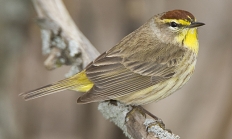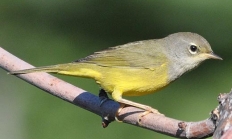Search myodfw.com
World famous for its loud, persistent singing and mimic abilities, the Mockingbird is highly conspicuous. The white flashes in the wings and tail of this grayish bird identify it in flight. It is primarily a southern species that has, by taking advantage of the environmental changes brought about by the ever-increasing human population, expanded its range northward in recent years. In many parts of the country it is a familiar bird of residential neighborhoods. Hear the call of the Northern mockingbird Photo by ©Keith Kohl, ODFW

More often heard than seen, this eloquent singer is the quintessence of the sage-dominated Great Basin. Its pale eye, short bill, brownish-gray back, boldly streaked breast, and long, white-cornered tail distinguish this towhee-sized thrasher. It is often glimpsed darting or running low across the road, tail corners flashing, then disappearing abruptly into the brush. Its aerobatic display flight and tireless vocalizations are its most outstanding features. Hear the song of the Sage thrasher Photo by Tom Benson, Flickr

These small, buff ground-dwellers are often seen in migration as they pass overhead in lisping flocks or as they walk deliberately along a muddy shore, tilled field, or short-grass upland with their tails slowly bobbing. Breeding birds are grayish above and lightly streaked below; winter birds are more heavily streaked below and brownish above. All plumages have cream-buff undersides (brightness varies) and a dark tail with white outer feathers. The American pipit is locally common in lowlands in winter, especially in western Oregon and on the coast. Hundreds of pipits can be found some years in preferred habitat in the

The Bohemian waxwing is a nomadic species, invading locations with fruit-bearing trees or shrubs. Referred to as a "roving bands," their name reflects this view of their unpredictable and seemingly carefree lifestyle. Very sociable birds, they exhibit pronounced flocking habits in the winter, and frequently give themselves away with their constant gentle seeping or trilling voice. Their sleek profile and elegant, almost exotic coloration also distinguish these birds. Hear the song of the Bohemian waxwing Photo by Kathy Munsel, ODFW

Although called warblers, many of these perching birds may not necessarily be closely related to one another. They are usually easier to hear than see.

This rather plain warbler breeds across Canada from the Atlantic coast to central British Columbia and southern Alaska. The main migratory route is east of the Rocky Mountains, but small numbers regularly migrate along the west coast. The Tennessee warbler is most often found in deciduous groves or mixed woodlots. It is similar in plumage to the Warbling vireo, though its habits are more active and warbler-like. Care should also be taken to distinguish this species from gray-headed Orange-crowned warblers. Hear the song of the Tennessee warbler Photo by Russ Wigh, Flickr

This olive-green warbler is one of the drabbest of Oregon's Warblers., often showing obscure streaking on the underparts and indistinct dark eyeline. The species is named for its telltale orange crown spot but this feature is often hidden, reduced or absent in immature and female birds, and therefore rarely observed in the field. Orange-crowned warblers are one of the earliest and most abundant migrants in Oregon. They glean insects from the undersides of leaves and are often seen probing into dead leaf clusters and flower heads. Perhaps this is why they are able to winter farther north than most other

This inhabitant of riparian thickets and brushy clear-cuts and pastures breeds from northeast British Columbia across southern Canada to the east coast and south to Georgia. The main migratory route is east of the Rocky Mountains, but small numbers of transients are reported almost yearly in Oregon. Spring records are between mid-May and mid-July. There are fewer fall records than in spring most occurring between mid-August and mid-October. Hear the song of the Chestnut-sided warbler Photo by Yankech Gary, Flickr

One of the first migrants to brighten Oregon woodlands with song is the Black-throated gray warbler. As early as the first week in April, the distinctive buzzy song announces the male's arrival in habitats from riparian forests to juniper woodlands, chaparral to Douglas-fir forests. It sings even as it darts through the canopy and understory in search of insects. Except for the small yellow spot in front of the eyes, the male is an essay in black, gray and white. The cap and throat are black, as is the cheek which is outlined in white. The back is gray, striped

A dreary winter day can come alive with a flock of these striking birds foraging quietly in a dark green conifer. Though a common migrant and uncommon winter resident, it breeds largely to the north of Oregon. The Townsend's warbler is a common breeder in the Blue and Wallowa mountains of northeast Oregon and a local summer resident in the vicinity of Mt. Hood and in the central Cascades. Hear the song of the Townsend's warbler Photo by Doug Greenberg, Flickr

One of the most numerous breeding birds in Douglas-fir and true fir forests of western Oregon is the Hermit warbler, yet it is often overlooked. This may be surprising, given the male's bold colors; however, it seldom descends from the higher reaches of the forest canopy. If you are familiar with its song, you can often hear three to five males singing on a spring morning from many places in appropriate habitat. The male Hermit warbler has a bright yellow head, set off by a black throat and nape. The gray back is marked with black stripes that vary in

Palm warblers constantly pump their tails in a down-then-up motion, more so than any other warbler. They also walk and run on the ground more than most warblers. A key field mark is the bright yellow undertail coverts which contrast with whiter underparts. Palm Warblers are hardy warblers, migrating early in the spring and late in the fall. Birds presumably Palm warblers are regular fall transients on the outer Oregon coast and irregularly remain through the winter and spring. They are occasional spring and fall transients in the Willamette Valley and have been found wintering there. Hear the song of

This warbler of the boreal forest breeds in Alaska and across northern Canada to the east coast and south to Pennsylvania. It migrates along the east coast to winter in South America. It is a regular transient elsewhere east of the Rocky Mountains and in California. In Oregon it is reported in small numbers almost annually with most records being immatures from Harney County and along the immediate coast. Hear the song of the Blackpoll warbler Photo by D. Faulder, Flickr

One of Oregon's rarest and most local breeders, this vocal but somewhat secretive warbler can be heard and sometimes seen in summer in the south central Cascades. The patient observer may catch a glimpse of a chunky, dark-backed bird feeding low in dense willows, sometimes showing its pale underparts with dark streaks. It is otherwise a rare migrant or vagrant statewide, mostly in Spring. An isolated population of this species has summered and presumably bred in the south central Cascades. No nest has been found in Oregon, owing mainly to the impenetrable habitat. Reports suggest that a small population may

During the breeding season, this gray-hooded warbler is conspicuous, singing boldly from riparian thickets, clear-cuts, and roadside brush. However, when household cares occupy the daylight hours, they become elusive as field mice, slipping about through the thickets like shadows, only the sharp alarm note betraying their presence to an intruder. After many minutes of careful pursuit, an observer is often left with only a brief glimpse of an olive-colored back or a broken white eye-ring. MacGillivray's warbler is one species that appears to thrive in areas that have been disturbed by industrial forest practices. It has been reported from every

The golden-yellow face and breast of the male Wilson's warbler distinguish it as one of the brightest of Oregon's breeding warblers. Adult females are similar in plumage to males, and may even have a full black cap; however, the caps of females are smaller and duller than those of males, and are flecked with olive green. These lively warblers nest and forage for insects in tall, dense shrub growth, understory, or riparian thickets. It is an abundant breeder in woods and tall shrubs in the Coast Range, and is common in the Willamette Valley and west Cascades. Hear the song

The chat's coming in the spring is like the arrival of a brass band. Male chats are loud, continuous singers, sometimes heard through the night. Chats inhabit lowland tangles and thickets along rivers and floodplains. It is the largest of North American warblers. In western Oregon, the chat is an uncommon to common summer resident of the interior Rogue Valley. It is a locally uncommon summer resident in the interior Umpqua Valley. In the Willamette Valley it is a locally rare to uncommon summer resident, and rare east to Oakridge. In eastern Oregon, the chat is a rare spring migrant

Towhees, sparrows, grosbeaks and buntings are ground-dwelling birds that are typically drab looking. They feed on insects in summer and seeds in winter.

A large and colorful member of the sparrow family, the Green-tailed towhee is perhaps more recognizable by its eye-catching chestnut crown than by its less intense green-gray back and olive tail. As a ground forager, it spends most of its time on the ground or in thick cover, scratching about industriously in the leaf litter, and it may go unnoticed. But its catlike mewing call, which it often gives from a brushy perch, is one of the quintessential sounds of the shrublands of the east slope of the Cascades and the Great Basin. It is locally fairly common east of

This well-known ground-dwelling bird is black above on the male and brown on the female, including the entire head and upper breast. On both sexes the upperparts are spotted with white on the wings and the long tail. It has rufous sides and a white belly. It frequents brushy areas and is common at bird feeders wherever seed is scattered on the ground, but does not feed far from cover. The varied song usually has one to three parts. The Spotted towhee breeds statewide and winters primarily west of the Cascades and in small numbers in lowland areas east of

